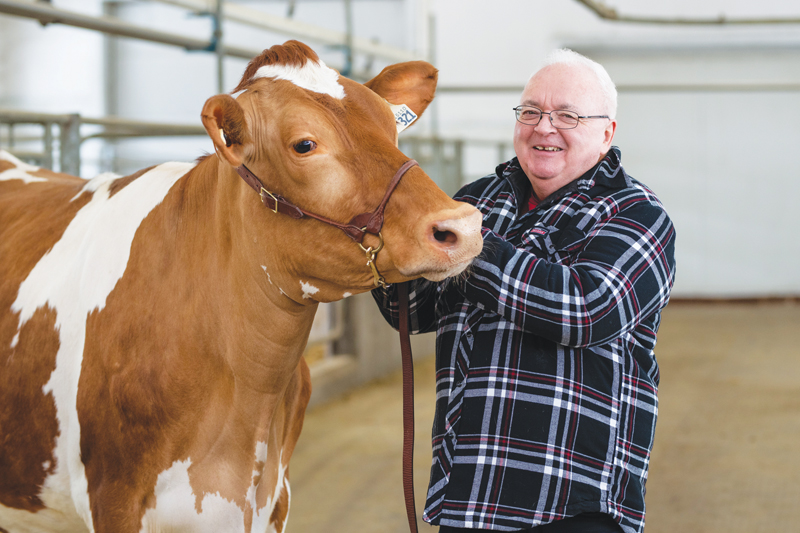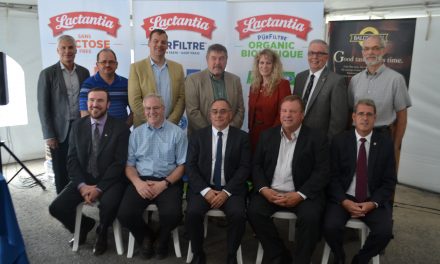Canadian Guernsey Association fieldman Russell Gammon would like to see the breed utilize genomic testing to breed for cows that will fit into the future of the dairy industry. McFarlane photo

McFarlane photo
by Holly McFarlane
AgriNews Contributor
GUELPH – The Guernsey cow, so the story goes, made her debut on Canadian soil accidentally. According to the Canadian Guernsey Association, Guernsey cattle en route to the New England states via ship were forced to land in Nova Scotia due to rough waters. The breed impressed so many people that local residents requested the federal Minister of Agriculture import Guernsey cows to Canada. In 1878, Sir John Abbott made the official importation of Guernseys. The breed became very popular in the Maritimes and eventually, several herds were relocated and established in British Columbia. Over multiple decades, the breed has seen a significant decline in numbers. It begs to ask the question; are Guernseys a thing of the past or are they a breed to discover?
The Canadian Guernsey Association annual general meeting will be held at EastGen in Guelph on March 25. General questions and inquiries associated with the breed can be sent to info@guernseycanada.ca.
Today’s Guernsey finds herself to be somewhat of a hidden treasure. Increased demand for food products sourced locally is having a substantial influence not only on what is brought home to our refrigerators but to the sustainability of local farms and the farming community as a whole. With on-farm processing becoming more relevant throughout Ontario and beyond, the Guernsey breed can be easily utilized to produce dairy products that fit nicely into a niche marketplace.
“I don’t know why within supply management we didn’t have some separation from the beginning,” says Russell Gammon, fieldman for the Canadian Guernsey Association. “These producers are still selling their milk through the quota system to DFO. If we were smart, we would have done this all along! Now we have the Upper Canada Cheese Company, Limestone Creamery, Eby Manor, Little Brown Cow and Miller’s Dairy, Sheldon Creek Dairy and numerous other on-farm processors. The Guernsey cow somewhat relates to the segregation of the market and selling specialized products with their milk. It really offers reasonable potential for someone with the passion to pursue and take advantage of this,” says Gammon.
Today’s consumers demonstrate a heightened appreciation for a safe, locally grown food product. This offers a potential opportunity for new entrants or those new to the Guernsey breed, as a number of these on-farm processors require additional milk supply from local herds to meet their retail demand for milk, cheese and other dairy products.
Gammon, no stranger to the dairy industry, has dedicated the majority of his career to the overall growth and advancement of the Jersey cow with tremendous success. Early in his career, after completing his studies at the University of Guelph, he found himself working as the Ontario Guernsey fieldman for the summer.
“I visited approximately 225 Ontario farms that summer, all of which had 1-2 Guernseys (or more) in their herds. Today, I visit 10-15 farms throughout the province that currently own Guernseys,” says Gammon, emphasizing the decline in popularity of the Guernsey breed. “If you saw Guernseys on a farm back then, they were usually the last ones. While, now, if you see Guernseys on a farm, they are more than likely the first ones!”
Ten months into his current role as fieldman for the Canadian Guernsey Association, Gammon describes the Guernsey breed as gentle, likeable, resilient, high quality and surprising. Anyone who knows Gammon, even if it be a brief exchange, has likely experienced his all-in passion and excitement for anything he pursues. It’s no surprise that he has breathed new life, so to speak, into the presence of the Guernsey breed on social media platforms and events throughout Ontario and beyond. Gammon has charged ahead, actively collaborating with the Canadian Guernsey Association’s approximately 45 members to provide advice and support, be it via email or phone, social media or on-farm.
The Guernsey difference
Guernsey cattle are appreciated for their ease of management; a quiet nature, high calving ease, feed conversion efficiency, and their ability to adapt in various dairy housing systems. Producing high quality, beta-casein and component rich milk, Guernseys have gained a following of consumers who can’t get enough of the milk’s fresh golden, whole-bodied flavour. The breed has recently seen some renewed interest, with a small number of new herds added within Canada in the past couple of years. With only a small Guernsey population here in Canada there is a significant opportunity for growth and breed advancement. Continuing to build momentum, the Canadian Guernsey Association will assist and support new entrants currently working to develop new herds and begin miking in the near future.
Overcoming breed obstacles
Any breed represented by a small population is bound to face various challenges. Gammon notes that proving new sires has been exceptionally difficult due to a very low number of daughters within the breed. In the past, breeding programs have placed heavy emphasis on stature over other traits. Gammon explains that a strong focus to develop a bigger Guernsey cow has perhaps sacrificed the capacity and reproductive performance of the animals.
“You need calves to grow a population,” emphasizes Gammon. “Striving to work on reproductive efficiency within the breed is key. A shortage of variety amongst sires, with possibilities of close breeding, can prove challenging.”
Looking forward to the future of the breed Gammon states: “I would like to see more adoption of genomic testing, and using genomic selection to breed for cows that will fit into the future of the industry; cows that are strong, produce really well, yet maintain their components. If one was to get serious with genomic testing, you could really take a leap forward with respect to your genetics. It’s easy to stand out in a small population, and there are many opportunities to market breeding stock from great herds.”
Improving on-farm member support
The Canadian Guernsey Association and Holstein Canada announced a new and exciting collaboration of field services that promises to provide both Atlantic and Western Canadian Guernsey producers with expanded field support. The associations announced Feb. 7 that Morgan Sangster, Holstein Canada field service business partner, will work with Guernsey owners in Manitoba, Saskatchewan, Alberta and British Columbia. Field service business partner Natasha McKillop will provide the same services in New Brunswick, Nova Scotia, Prince Edward Island and Newfoundland. Ontario and Quebec will receive continued support from Gammon. “Guernseys in Western Canada have had limited contact with representatives from the association. Now they will have a face that can be present on their farm; someone really knowledgeable that can talk Guernsey and understands the challenges of the breed,” says Gammon.
A golden opportunity
The Kaiser family owns and operates a dairy farm in Noyan, Que., milking 120 Holsteins and 10 Jerseys. In 2017, following the family’s acquisition of a long-running dairy processing plant, Laiterie Chagnon, the Kaiser family became interested in expanding into a specialized market focused on A2 dairy products. After much research, they decided there was significant merit in inquiring about the Guernsey breed. With the help of the Canadian Guernsey Association, Christian Kaiser was directed to Brent Clements in the United States, who assisted Kaiser in sourcing Guernsey cows that would suit his needs.
“I have come to realize there is a lot more to the Guernsey breed than their high-quality milk. The breed is much more curious and calm than a Holstein, but far less mischievous than a Jersey,” says Kaiser, who manages the farm. “They have tremendous feed efficiency. We have some animals outproducing our expectations. They are a very competitive cow when you break down their production and efficiency in comparison to other breeds.”
A great example is Jens Gold Profit Eunice, a two-year-old in the herd who is currently 276 days in milk, milking over 40 kg daily at 4.8 per cent fat. All Guernseys who entered the herd were genomic tested before purchase, and Kaiser continues to genotype all new calves and new cattle added to the existing herd. Currently milking 32 Guernseys under the prefix Cremedor, Kaiser is set up with a second milk tank to separate out the Guernsey A2 milk. The milk is then processed at Laiterie Chagnon to produce Greek yogurt in various flavours, as well as a 5% whole milk. In March 2020, the Kaiser family is planning to offer a 5% chocolate milk for retail throughout Quebec.
Kaiser is currently focused on continuing to develop their flush program. “The reproduction aspect of our herd is performing much smoother than I anticipated,” says Kaiser. “Conception rates have been very good, and I carefully monitor daughter fertility within our breeding program. We are interested in introducing IVF, as well as working toward flushes that result in a larger number of viable embryos. We currently implant all embryos in Holstein recipients and have had tremendous success. I was once told that IVF in Guernseys is the way to go! There is a lot of untapped potential with this breed.”
Does their milk really taste different? The answer is clear for Gammon: “I buy Guernsey milk because of its ease of availability local to me, and because of its very fresh taste. It’s supplied in a bottle, and I really enjoy washing that bottle and returning it. It feels like I’m doing something small, yet positive, for the environment!”













